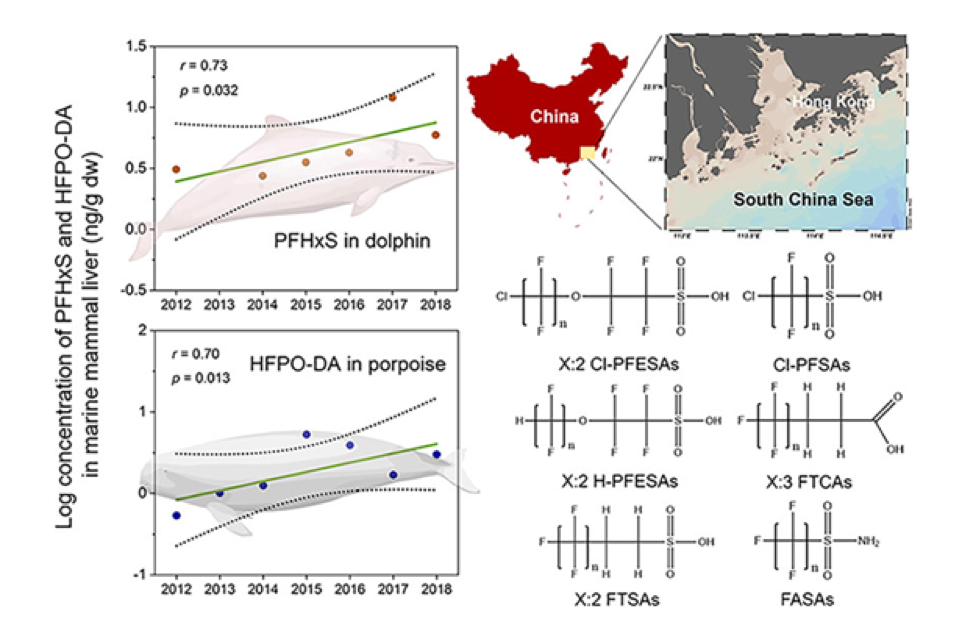Involved Members: Prof. Paul Kwan Sing LAM, Dr. James Chung Wah LAM, Dr. Phoebe Yuefei RUAN
For emerging chemicals of concern, in this case PFASs, in key environmental matrices, my research team has developed sensitive, reliable, and robust analytical methods. We developed a SPE-HPLC-MS/MS procedure to measure PFASs at parts-per-trillion (ng/L) levels in seawater; this study revealed for the first time the widespread occurrence of PFASs in Chinese and Korean waters. Our further studies revealed the occurrence of PFASs in Chinese rivers, surface waters between Asia and Antarctica, and open oceans. We then developed a new HPLC-MS/MS method to analyze short-chain PFASs. These results demonstrated the ubiquitous distribution of PFASs in the global environment, which laid part of the foundation for the standardized determination methods (HELCOM - Helsinki Convention; ISO).
Importantly, our analytical method was sensitive enough for measuring PFASs in open ocean waters. We then participated in a global study, which yielded important data lending strong support to the hypothesis that non-volatile PFASs were transported to polar regions via ocean currents. Our sensitive and selective method enabled the trace analyses of PFASs in ice core, surface snow, and water samples collected from Norwegian Arctic. As glaciers were formed by the compression of fallen snow over many years, the glaciers sampled, located at high altitude, was expected to receive PFAS contamination mainly from atmospheric pathways. Therefore, ice cores in this location were used to investigate the transport pathways of PFASs and provide information on the temporal trends of atmospheric concentrations of PFASs.
Melted glacier water further reflected atmospheric and local PFAS contamination over several years, while surface snow and water samples represented recent sources from both local and global sources. Our results comprehensively demonstrated the atmospheric transport of PFASs over and above the pathway via ocean currents. Collectively, our research contributed to the water monitoring guidelines issued by the United Nations Environment Programme (UNEP).
My research team further developed and validated analytical methods to determine PFASs in biological samples. Using this method, concentrations of PFASs were analysed in human blood, as well as human breast milk samples collected from China. One important finding was that the daily intake of certain PFASs for the child exceeded the predicted conservative reference dose, indicating that there may be potential risk of certain PFASs for the infants via the consumption of breast milk in China. We published two papers on the determina¬tion of total fluorine in water and blood samples. Using this method, we demonstrated that the PFASs being targeted for scientific investigation and/or environmental surveillance at that time actually represented only a very small fraction (around 10-30%) of extractable organofluorine compounds in the environment. Recently, these findings have raised widespread interest in the search for “unknown PFASs” among researchers in this field in order that a more comprehensive and meaningful risk assessment of organofluorine compounds can be conducted.
To assess the environmental and public health risks of PFASs, we studied the toxic effects of PFASs in rats; chickens; and on primary cultured fish hepatocytes. Following on from these, we successfully developed methods for measuring PFASs in bird eggs and cetacean tissues; as well as in tap water. More recently, we have studied the trophic biomagnification of PFASs in a wetland food web and examined the health effects to humans through the consumption of aquatic foods. Taken together, these studies contributed to the health advisory opinions issued by several authorities, such as the World Health Organization (WHO), Health Canada, United States Environmental Protection Agency, and OECD.
Phasing out of the legacy (mostly 8-carbon) PFASs has resulted in compensatory production and usage of alternatives, such as shorter- or longer-chain PFASs, and other structurally similar PFASs. These emerging PFASs are inevitably released into the environment. Our research has been concerned with the status and trends as well as the environmental impact of legacy and emerging PFASs. The information collected was used to manage (e.g., setting exposure limits or guideline values) or instigate a ban, if warranted, on the production and use of these chemicals by Global International Agencies (e.g., UNEP; WHO).
Reference:
Wang, Q., Ruan, Y., Jin, L., Zhang, X., Li, J., He, Y., Wei, S., Lam, J.C.W., Lam, P.K.S. (2021). Target, nontarget, and suspect screening and temporal trends of per- and polyfluoroalkyl substances in marine mammals from the South China Sea. Environmental Science & Technology, 55(2), 1045−1056.
